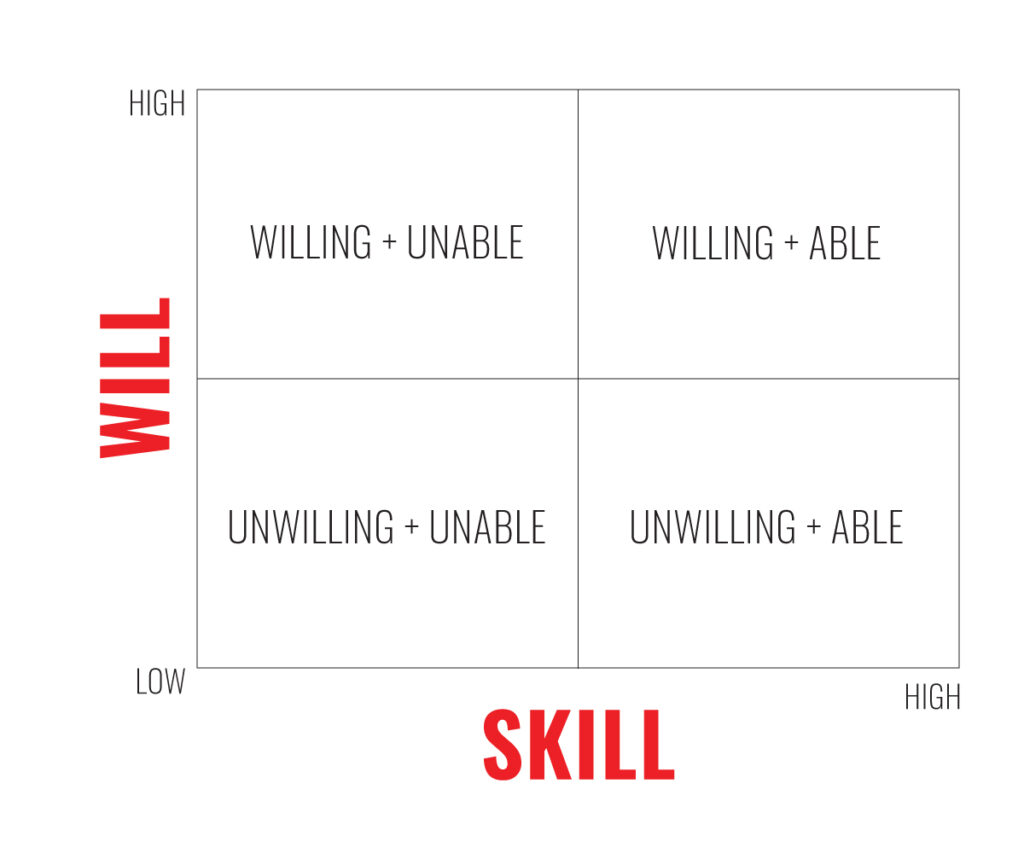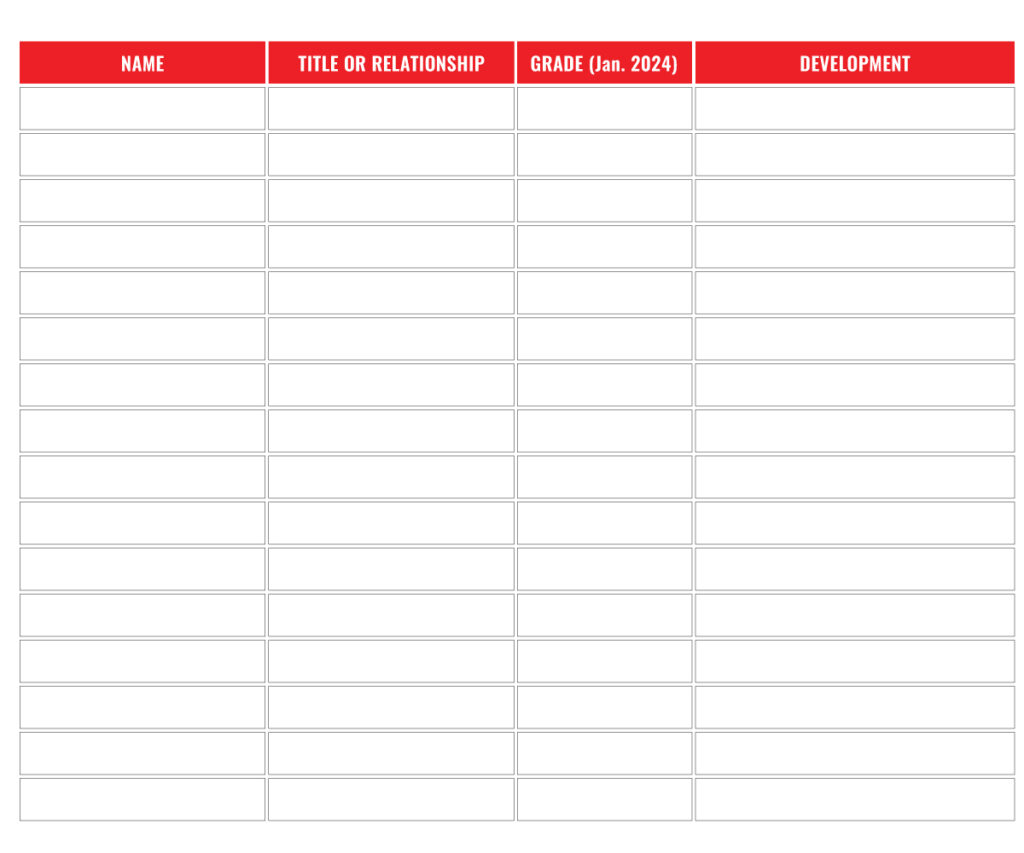
Grading Your Team
Published in Accountability, Conflict Resolution, Leadership, Organization Health, Strategic PlanningWho Are Your A, B & C Players?
As a new football season approaches, coaches are assigning grades to players and finalizing depth charts.
Top leaders should do likewise as strategic planning season approaches and teams assemble to plan their version of winning.
I’ve led more than 250 strategic planning sessions and believe two of the most significant outcomes of a planning session aside from the plan itself are 1) an assessment of talent and 2) alignment around the plan.
Ask yourself:
- Does this team have what it takes to get us where we want to go?
- Who’s a good cultural fit but is in the wrong position? Who needs to go? Who are we missing?
- On a scale of 1 – 10 (with 10 being highest), how aligned is our team around our values? Our vision? Our plan to achieve our vision?
What’s Your Coaching Cadence?
By whatever name you call it—assigning grades, assessing ability or conducting performance reviews—knowing your people (and I mean really knowing them) and developing them are leadership responsibilities. This work is not an HR function.
The performance review process has been changing over the past ten years and the reason is simple: most performance reviews suck. Many formal sit-downs are infected by corporate gamesmanship and watered down with so much euphemistic language and inconsistent feedback that studies show half the people conducting the review and half those being reviewed don’t believe they’re accurate.
If that’s not enough, the time drain for developing an annual performance review can generate more stress than excitement around the prospect of getting helpful feedback to improve individual performance.
To improve this process, companies are moving to monthly and quarterly reviews that are more immediate, less time-consuming and (as a result of the frequency) more honest and therefore more useful. Studies indicate about one in four firms in the U.S. have adopted this cadence.
It makes sense. You train a pet and correct your kids in the moment—not six months after the learning opportunity has faded from memory.
Determining A, B and C Players
How do you evaluate whether a person is a good cultural fit? How do you measure competence? How do you identify potential?
Here’s food for thought.
A Players leap tall buildings in a single bound. They’re rock stars. They’re self-starters who need little direction. To get even more from them, remove barriers that hinder their performance, give them the resources they need, stay out of their way and let them perform. Tell ‘em you love ‘em with money, recognition and more responsibility. Trait to look for: The ability to inspire people who want to be on their winning team.
B Players use the front door. They’re steady performers but often have difficulty casting a vision that’s bigger than a budget. They do what’s expected and little more so training rarely works. They’ve hit a ceiling—either with their capacity to perform new types of work or because they’re happy doing the work they’re doing. They want and need someone to tell them what to do. Trait to look for: Competence in current role but lacking curiosity to imagine what else and unable to inspire others.
C Players have trouble finding the parking lot. Mistakes happen; underperformance is a pattern. Do these players not know or not care? If they don’t know how to do their jobs, their deficiencies must be addressed or you’ve set a new standard. They want and need a person to manage them into a job—or out of one by helping them realize they can’t meet their manager’s or the organization’s expectations. If, on the other hand, the person doesn’t care, you’re dealing with a dangerous player who’s mostly capable, perhaps influential and potentially toxic. They want and need a person to help them find a motivating factor that can be applied in their job. In both cases, the trait to look for is inconsistency.
D Players don’t know it’s a workday. These people don’t get it, don’t bring their “A Game,” and their performance is consistently substandard—whether it’s because of their mindset or technical skill. Why are they still on your payroll? Better yet, how did they get on your team? This is a hiring mismatch that no amount of talk, training or second chances will fix. Trait to look for in yourself, not in them: What story am I telling myself about this underperformer?
While it’s true that working with human beings can be messy, uncomfortable and imprecise, two simple models have stood the test of time and it’s likely you’re using some version of one or the other.

I favor simplicity so I prefer this model:

Whatever model you use for gauging talent, remember that every person on your team wants answers to these five questions:
- Why are we here? (Our purpose beyond making money.)
- What do you want me to do? (Clarity around role, responsibility and authority.)
- How am I doing? (This is the accountability question.)
- What’s in it for me? (Hint: It can be money but not always.)
- Where do I go for help? (This is a culture question.)
Accountability is one of the most important factors in determining the success of an individual, a team or an enterprise, and accountability starts with you and your team.
This year marks the tenth anniversary of McGraw-Hill’s publication of my bestselling book, Accountability: The Key to Driving a High-Performance Culture and people continue to tell me the case studies, lessons and exercises are as fresh as ever.
The Leader as Coach
If you’re a leader you’re a coach.
A few years ago, I developed a form for members of my Vistage groups.
The instructions are simple: List and then assign a grade to the people of significance in your life with an A, B or C. No D players: you must take action to remove your D players because they don’t fit.
Once you make your list of A, B and C players, write down one thing you’ll do over the next twelve months to help your colleagues develop and grow. Hint: For A players, it may be removing a barrier or providing more responsibility—indicators to them that they’re important and have a bright future. For B players, it may be coaching them to develop a skill, including the skill of leading others. For C players, it may be identifying a behavior or habit that’s causing inconsistent performance.

When your list is complete, ask yourself: What’s it like to be coached by me?
Leave ‘em Laughing
If you’re still reading and want to smile, chuckle or even laugh out loud, check out my blog from last September: “The Humor of Football Coaches.”
Ready to reset?
Attend my free Accountability webinar: I Did It! to set and achieve your 2021 goals.
- February 17th from 11 AM – 12:30 PM Central Time
- My free webinar will help you:
– Sharpen your personal goals
– Improve time management
– Tackle tough work-related issues
– Support remote workers
Learn More
To dive even deeper into the topic of accountability, I invite you to purchase a copy of my bestselling book, “Accountability: The Key to Driving a High-Performance Culture.”
Become a better leader.
Download my three free e-books.
Free Tips
Sign up to receive free tips on business, leadership, and life.
Get My Latest Book
HOW LEADERS DECIDE
History has much to offer today’s current and aspiring leaders.
Business schools teach case studies. Hollywood blockbusters are inspired by true events.
Exceptional leaders are students of history. Decision-making comes with the territory.



